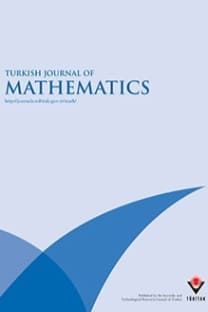Inclusion properties of Lucas polynomials for bi-univalent functions introduced through the q-analogue of the Noor integral operator
Inclusion properties of Lucas polynomials for bi-univalent functions introduced through the q-analogue of the Noor integral operator
___
- [1] Akgül A. Coefficient estimates for certain subclass of bi-univalent functions obtained with polylogarithms. Mathematical Sciences and Applications E-Notes 2018; 6: 70-76.
- [2] Akgül A, Altınkaya Ş. Coefficient estimates associated with a new subclass of bi-univalent functions. Acta Universitatis Apulensis 2017; 52: 121-128.
- [3] Altınkaya Ş, Yalçın S. Faber polynomial coefficient bounds for a subclass of bi-univalent functions. C R Acad Sci Paris Ser I 2015; 353: 1075-1080.
- [4] Altınkaya Ş, Yalçın S. On the certain subclasses of univalent functions associated with the Tschebyscheff polynomials. Transylvanian Journal of Mathematics and Mechanics 2016; 8: 105-113.
- [5] Arif M, Ul Haq M, Liu J-L. Subfamily of univalent functions associated with q -analogue of Noor integral operator. J Funct Spaces 2018; 2018: 3818915.
- [6] Brannan DA, Taha TS. On some classes of bi-univalent functions. Stud Univ Babeş-Bolyai Math 1986; 31: 70-77.
- [7] Fekete M, Szegö G. Eine Bemerkung über ungerade schlichte Funktionen. J London Math Soc 1933; 2: 85-89 (in German).
- [8] Filipponi P, Horadam AF. Derivative sequences of Fibonacci and Lucas polynomials. Applications of Fibonacci Numbers,1991; 4: 99-108.
- [9] Lee GY, Aşcı M. Some properties of the (p; q) -Fibonacci and (p; q) -Lucas polynomials. J Appl Math 2012; 2012: 1-18.
- [10] Lewin M. On a coefficient problem for bi-univalent functions. P Am Math Soc 1967; 18: 63-68.
- [11] Lupas A. A guide of Fibonacci and Lucas polynomials. Octagon Math Mag 1999; 7: 2-12.
- [12] Netanyahu E. The minimal distance of the image boundary from the origin and the second coefficient of a univalent function in jzj < 1. Arch Ration Mech Anal 1969; 32: 100-112.
- [13] Noor KI. On new classes of integral operators. J Natur Geom 1999; 16: 71-80.
- [14] Sakar FM. Estimate for initial Tschebyscheff polynomials coefficients on a certain subclass of bi-univalent functions defined by Salagean differential operator. Acta Universitatis Apulensis 2018; 54: 45-54.
- [15] Sakar FM. Estimating coefficients for certain subclasses of meromorphic and bi-univalent functions, Journal of Inequalities and Applications 2018; 283: 1-8.
- [16] Srivastava HM. Univalent functions, fractional calculus, and associated generalized hypergeometric functions. In: Srivastava HM, Owa S, editors. Univalent Functions; Fractional Calculus, and Their Applications. New York, NY, USA: John Wiley and Sons, 1989.
- [17] Srivastava HM, Mishra AK, Gochhayat P. Certain subclasses of analytic and bi-univalent functions. Appl Math Lett 2010; 23: 1188-1192.
- [18] Vellucci P, Bersani AM. The class of Lucas-Lehmer polynomials. Rend Math Appl 2016; 37: 43-62.
- [19] Wang T, Zhang W. Some identities involving Fibonacci, Lucas polynomials and their applications. Bull Math Soc Sci Math Roum 2012; 55: 95-103.
- ISSN: 1300-0098
- Yayın Aralığı: 6
- Yayıncı: TÜBİTAK
Inverse problem for Sturm–Liouville differential operators with two constant delays
Ben WONGSAIJAI, Nattakorn SUKANTAMALA
Osman ALTINTAŞ, Nizami MUSTAFA
Study on the existence of solutions to two specific types of differential-difference equations
On λ-pseudo q -bi-starlike functions
Prakash KAMBLE, Mallikarjun SHRIGAN, Şahsene ALTINKAYA
Complete flat cone metrics on punctured surfaces
